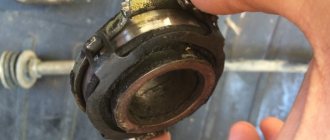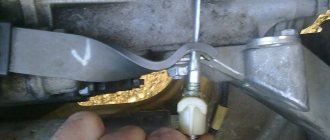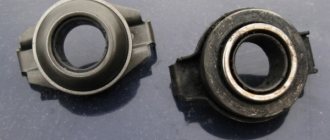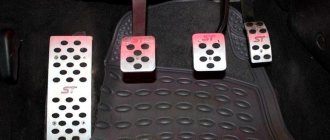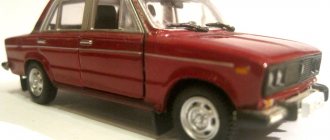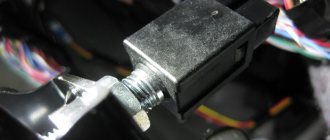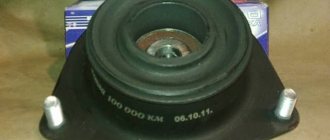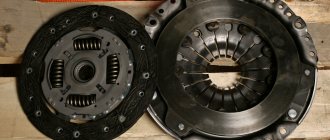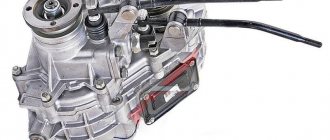Release bearing in clutch - types, principle of operation, breakdowns
Today, the most common type of clutch is the dual-disc design.
One of them is the leader, the other is the follower. The first one is rigidly fixed to the crankshaft, and the driven one transmits torque. In order to change gear, you need to disconnect the clutch discs. This function is performed by the release bearing, which can pull the drive disk to the side. Despite the prevalence of this design, not all motorists know enough information about the release bearing. Hydraulic bearings operate using hydraulic force
Kinds . First of all, release bearings can be classified by type. Conventionally, they are divided into 2 types: 1) roller or ball; 2) hydraulic. Roller or ball bearings operate using mechanical action. This type is not found in modern vehicles. Previously, they were used on cars such as Moskvich and the first VAZ models. Hydraulic bearings operate using hydraulic force. The main difference is that the clutch pedal is easier to depress.
Principle of operation . Clutch operation is not very difficult. The release bearing in the system is responsible for connecting and disconnecting the clutch discs. This happens at the moment when the driver presses the clutch pedal. Let's look at the process in more detail. 1. The driver depresses the clutch pedal. 2. The driven disk is pulled towards the flywheel using hydraulic force - this provides clutch. 3. The spring creates pressure on the pressure plate. The latter have internal petals on which the bearing acts. 4. The bearing is driven and ensures the separation of the discs.
Malfunctions . The release bearing in the clutch system has its own life, but in some cases, breakdowns occur ahead of schedule. This occurs due to uneven load when the driver depresses the clutch. At this moment, the bearing moves back with the driven disk. This is why experts do not recommend keeping the clutch pedal depressed for too long. If you hear a knocking sound when you press the pedal, this indicates a broken or worn bearing.
The new bearing should turn without any extra effort.
To replace the element, you need to remove the gearbox, disconnect the ends of the clutch spring retainer, pull out the bearing, remove the spring retainer and remove the old bearing. Before installing a new part, you need to lubricate the seat of not only the bearing, but also the bushing. After this, the mechanism must be assembled in reverse order. Be sure to check the functionality of the part after installation. The new bearing should turn without any extra effort. Many motorists cannot determine the bearing life by hearing or pressing. Constantly disassembling the box is also not the best option. Therefore, it is useful to know the average resource of a given element. Typically, a release bearing can last up to 150,000 km. However, this indicator applies to those cases when the car and mechanism are operated without unnecessary loads. If the vehicle is used by a beginner, this figure can be reduced to 50,000 km.
Bottom line . The release bearing is an important element in a modern clutch system. Over time, the part fails and requires replacement, as indicated by some signs.
Source
Possible malfunctions, their symptoms and diagnostics
The design and principle of operation of a chainsaw oil pump
No special equipment is required for diagnosis. The symptoms are eloquent and difficult to confuse with other elements. It is enough to listen to the car yourself while pressing the pedal.
Signs of a faulty release bearing:
- whistling, crunching, localized in the pedal area;
- characteristic knocking sound of the drive when the engine is running;
- shocks when pressed, pedal wedge;
- Difficult gear shifting, sometimes accompanied by extraneous sounds.
How to check the release bearing:
- start the engine, put the gear in neutral;
- press the clutch, listen to extraneous noises;
- engage the gear and slowly release the pedal.
The occurrence of at least one of the described symptoms indicates the need to replace the bearing. Delaying the procedure threatens its complete destruction.
How to check the clutch release on a car:
Signs of a faulty release bearing:
When diagnosing, remember the features of VP:
The sound of a pressed pedal does not always indicate a malfunction. This is normal in cold weather. Rollers (balls) are made of steel that does not have large linear expansion. The holder is cast from heat-treated metal. This difference can cause a gap to appear that is acceptable for operation.
How to replace a release bearing
Operations for replacing different types of squeezing devices have similar technological steps. Let's look at mechanical and hydraulic structures using specific examples.
Mechanical clutch type. Step-by-step instruction.
For clarity, let’s take a VAZ 2114 car. Before starting disassembly, ensure sufficient lighting of the gearbox. Prepare your workplace and tools.
Advice:
It is recommended to perform the gearbox removal operation in a pit. This ensures full access to the checkpoint. The help of a partner will not be superfluous.
Photo report of gearbox removal:
After removing the transmission from the vehicle, you can proceed to replacing the spare part:
- Carefully inspect the inside of the bell. Make sure the fork fastening is intact. If there are signs of damage, replace it.
- Locate the edge of the spring that secures the clutch. Use a screwdriver to pry off the bearing.
- Clean the shaft splines of old grease and dirt.
- Let's start replacing the part. Lubricate the seating surfaces and gearbox shaft. Use CV joint lubricant.
- We put the new part on the shaft. Install the retaining spring.
- Check the axial travel of the coupling. It should be free of jams.
- We check the rotation of the rollers (balls). There should be no rolls, wedging or other defects in the process.
This completes the replacement. The gearbox can be installed in reverse order.
Advice:
Be sure to check the condition of the driving and driven clutch discs and basket.
Photo report of VP replacement
Hydraulic clutch type. Step-by-step instruction.
As an example, consider a Ford Focus 2. The preparatory stage consists of removing the gearbox from the engine.
Advice:
The box mounting bolts vary in length. Be sure to label them before unscrewing.
Photo report of gearbox removal:
Replacement of the release bearing is carried out according to the following plan:
- We inspect the inside of the protective casing. We remove oil, dirt, and wear products from friction linings and clean the space.
- Unscrew the bolts securing the spare part housing. Remove the element from the gearbox shaft.
- We clean the seating surface from traces of oil and dirt.
- We install the new part on the shaft. Tighten the bolts of the fluid coupling housing.
- We check that the pipe-to-fitting adapter is installed correctly.
- We install the transmission on the car according to the instructions.
Upon completion, it is necessary to bleed the hydraulic drive system to remove air. It is recommended to carry out the operation with a partner. After each deep pedal press, unscrew the outlet fitting and release the air. Repeat the procedure several times.
Advice:
Carefully inspect the fluid inside the clutch reservoir. It should not be cloudy or dirty. Otherwise, remove it with a syringe, fill in a new one and bleed the system.
Photo report of VP replacement
The design and principle of operation of a car clutch
A clutch is a transmission mechanism that transmits torque from the engine to the gearbox through friction. It also allows you to briefly disconnect the engine from the transmission and reconnect them smoothly. There are quite a few types of clutches. They differ in the number of driven disks (single disk, double disk or multi-disk), the type of operating environment (dry or wet) and the type of drive. Different types of clutches have their respective advantages and disadvantages, but the most common on modern cars is the single-plate dry clutch, either mechanically or hydraulically driven.
Solving the problem
There are many reasons for clutch failure, but in this article we will describe one of the most common, namely the failure of the release bearing.
Release bearing
The release bearing is an important part, and any car owner should know how to prevent it from breaking and malfunctions, and if this happens, how to replace it correctly.
Causes of failure
The release bearing is influenced only when the pedal is depressed, at which point it is pulled back, as if it were moving the driven disc. As a result, if you hold the clutch for a long time at the engaged speed, there is a load on the bearing, which can cause rapid wear or malfunction. However, if used correctly, no repairs will be needed.
Has your release bearing failed?
Survey
- No (100%!, 1 Vote)
- Yes (0%!, 0 Vote)
Total votes: 1
Loading …
Signs of release bearing failure
Symptoms of wear on the release bearing are typical knocking noises when pressing the clutch while the engine is running. But if this knocking noise mainly increases at low temperatures, then there is no need to worry. Because this part is made of very strong steel, which has relatively low expansion. The glass in which the bearing itself is located, on the contrary, is very sensitive to temperature changes.
Changing the release bearing
To make a replacement you must:
- Remove the gearbox (removing the gearbox will be described below).
- The ends of the clamp disengage from the coupling.
Disconnect the clamp from the coupling
- Remove the bearing from the sleeve along with the coupling.
Removing the coupling
- Remove the bearing from the coupling on which it is located.
Squeeze the petals and remove the bearing - Carefully inspect the bearing you are about to install.
Rotation in it must occur freely, backlash is unacceptable. Before installation, inspect the condition of the new bearing - When installing a new one on the clutch, make sure that part of its inner ring is directed to the side.
- Secure it in this position - a special lock is provided for this.
- Lubricate the bushing with grease.
- Install the bearing.
- The coupling must be secured with a special clamp.
- Install the gearbox.
Removing the gearbox
Advice: it is better to remove the gearbox with a partner.
Before removing the gearbox, it is necessary to remove the battery and drain the transmission oil, and the starter must also be disconnected. These procedures are simple, so we will not dwell on them in detail.
- Disconnect the clutch cable and remove it from the bracket.
- We disconnect the block from the speed meter; to do this, you need to compress the spring clips.
Disconnecting the block
- We unscrew the bolts securing the ignition module bracket to the gearbox and the bolts securing the gearbox to the engine.
- At the bottom of the car, disconnect the wires connecting the block to the light switch.
- We unscrew the bolts attaching the torque rod bracket to the gearbox.
Unscrewing the bracket mounting bolts - We loosen the fastening of the traction clamp, which is responsible for shifting gears.
- Disconnect the rod from the speed selector rod hinge.
- We remove the wheel drives.
Removing the wheel drives - Unscrew the nut securing the gearbox to the engine.
- Unscrew the 3 bolts and remove the crankcase cover.
- We unscrew the bolt connecting the gearbox to the engine.
Unscrewing the bolt securing the box with the motor
- From the bottom of the car, unscrew the nut securing the left power unit support.
- Unscrew the nuts securing the rear support of the power unit to the body.
- Carefully slide the box along the guide bushings.
Principle of operation
The principle of operation of the clutch is based on a rigid connection between the clutch driven disc and the engine flywheel due to the frictional force generated by the force created by the diaphragm spring. The clutch has two modes: “on” and “off”. Most of the time the driven disk is pressed against the flywheel. Torque from the flywheel is transmitted to the driven disk, and from it through a splined connection to the input shaft of the gearbox.
Diaphragm spring operation diagram
To disengage the clutch, the driver presses the pedal, which is connected to the fork by a mechanical or hydraulic drive. The fork moves the release bearing, which, by pressing on the ends of the petals of the diaphragm spring, stops its pressure on the pressure plate, and it, in turn, releases the driven one. At this point, the engine is disconnected from the transmission.
After engaging the desired gear in the gearbox, the driver releases the clutch pedal, the fork stops acting on the release bearing, and it stops acting on the spring. The pressure plate presses the driven one against the flywheel. The engine is connected to the transmission.
Prevention of bearing failure. How to increase service life
Proper operation of the clutch pedal will not only preserve the release unit, but will also extend the service life of the entire device.
- Tip 1: Do not practice unnecessary sudden starts of the car from a standstill. At this moment, huge dynamic loads arise, contributing to bearing failure.
- Tip 2: There is no need to keep the clutch disengaged in traffic jams or at traffic lights. Place the car in neutral and release the pedal.
- Tip 3: Don't "throw" the clutch. For this reason, not only the bearings wear out, but also the disc. Excessive force only increases the negative effect of torque.
- Tip 4: Avoid situations where the car slips. To turn the wheels, enormous force is required, which is transmitted through the entire drive mechanism.
- Tip 5: When replacing a bearing, rely on the choice of trusted manufacturers. A table with recommended companies is presented below.
Types of clutch
Dry clutch
The principle of operation of this type of clutch is based on the friction force that arises from the interaction of dry surfaces: drive, driven and pressure disks. This ensures a tight connection between the engine and gearbox. A dry single-plate clutch is the most common type used on most cars with a manual transmission.
Wet clutch
This type of clutch involves the operation of the rubbing surfaces in an oil bath. Compared to dry, this scheme ensures smoother contact of the discs; the unit is cooled more efficiently due to fluid circulation and can transmit more torque to the transmission.
Double wet clutch
The wet circuit is usually used on modern dual-clutch robotic gearboxes. The peculiarity of the operation of such a clutch is that the even and odd gears of the gearbox are supplied with torque from separate driven disks. The clutch drive is hydraulic, electronically controlled. Gear shifting occurs with constant transmission of torque to the transmission without interruption in the power flow. This design is more expensive and difficult to manufacture.
Dry double-disc clutch
A dry double-disc clutch involves the presence of two driven discs and an intermediate spacer between them. This scheme is capable of transmitting more torque with the same dimensions of the clutch mechanism. In itself, it is easier to produce compared to wet. Typically used on trucks and cars with particularly powerful engines.
Dual mass flywheel clutch
The dual mass flywheel consists of two parts. One of them is connected to the engine, the second to the driven disk. Both components of the flywheel have a slight free play relative to each other in the plane of rotation and are connected by springs to each other.
Dual mass flywheel diagram
A special feature of the dual-mass flywheel clutch is the absence of a spring-loaded torsional vibration damper in the driven disc. The vibration damping function is built into the flywheel design. In addition to transmitting torque, it most effectively smoothes out vibrations and loads arising from uneven engine operation.
Clutch master cylinder VAZ 2101
Stable operation of the clutch master cylinder (MCC) has a direct impact on the functioning of the gearbox and its service life, as well as the smoothness of gear shifting. If the hydraulic drive breaks down, control of the gearbox becomes impossible, as does further operation of the vehicle.
What is it for?
The main function of the GCS is to briefly disconnect the power unit from the gearbox when changing gears. When you press the pedal, pressure is created in the system, which acts on the clutch fork rod. The latter drives the release bearing, controlling the clutch.
How it works
The main components of the node are:
- outer cuff;
- sealing collar;
- union;
- stock;
- return spring;
- frame;
- case for protection.
The GCS housing contains a return spring, cuffs, working and floating pistons
Principle of operation
The hydraulic clutch consists of two cylinders - the main and the working (GC and RC). The operating principle of the hydraulic drive is based on the following:
- Liquid enters the GC through a hose from the tank.
- When the clutch pedal is acted upon, the force is transmitted to the rod by a pusher.
- The piston in the main center moves out, which leads to the valve closing and compression of the liquid.
- After the fluid is compressed in the cylinder, it enters the hydraulic system through a fitting and is supplied to the DC.
- The slave cylinder drives the fork, which moves the clutch with the release bearing forward.
- The bearing presses on the friction spring of the pressure plate, releasing the driven disk, after which the clutch disengages.
- After the pedal is released, the cylinder piston returns to its original position under the influence of the spring.
The pedal moves the pusher, which, in turn, moves the piston and creates pressure in the hydraulic drive system
Where is
The GCS on the VAZ 2101 is installed under the hood near the vacuum brake booster and the master cylinder of the brake system. There are also reservoirs near the clutch cylinder: one for the braking system, the other for the hydraulic clutch.
The GCS on the VAZ 2101 is located in the engine compartment near the vacuum brake booster and the master cylinder of the brake system
When is replacement needed?
The cylinder elements wear out over time, which leads to interruptions in the operation of the mechanism. Repair or replacement of the main circulation system is necessary when the following symptoms appear:
- airiness of the system;
- leakage of working fluid;
- wear of cylinder components.
The presence of air in the hydraulic drive system disrupts the performance of the system, making its operation impossible. Air can enter the hydraulic drive through microcracks in the sealing elements of the cylinder or in the connecting hoses. If, when checking the system, a constant lack of fluid in the expansion tank is discovered, you need to inspect the entire clutch mechanism, since fluid can leave not only the master cylinder. If the amount of fluid in the hydraulic drive system is insufficient, the required pressure to move the clutch fork will not be able to be generated. This problem will manifest itself in the inability to separate the engine and gearbox when pressing the clutch pedal. If the leak is caused by wear of the connecting hoses, then replacing them does not raise any special issues. If the problem is related to the GCS itself, then the product will have to be dismantled, disassembled and the cause found out, or simply replaced with a new part.
Features of ceramic clutch
The life of the clutch and the efficiency of its operation at the load limit also depend on the properties of the material that ensures the engagement of the discs. The standard composition of clutch disc linings on most vehicles includes a compressed mixture of glass and metal fibers, resin and rubber. Since the principle of operation of the clutch is based on friction, the friction linings of the driven disc are designed to operate at high temperatures, reaching up to 300-400 degrees Celsius.
Clutch disc with ceramic friction linings
In high-performance sports cars, clutch loads are much higher than normal. Some transmissions may use ceramic or cermet clutches. The material of such overlays includes ceramics and Kevlar. Metal-ceramic friction material is less susceptible to wear and can withstand heating up to 600 degrees without loss of performance.
Manufacturers use various clutch designs that are optimal for a particular vehicle, based on its purpose and cost. The dry single-plate clutch remains a fairly effective and inexpensive design to manufacture. This scheme is widely used on passenger cars of the budget and middle classes, as well as SUVs and trucks.
Source
Replacement and repair
You can replace a failed release bearing yourself. Having little experience in car repairs, I carried out this procedure quite quickly. First of all, I remove the gearbox and disengage the spring clip. I remove the bearing from the guide sleeve. Using tools, I press out the “legs” of the spring holder and remove the part. Before installing a new one, I check it with special care. It’s better to carefully look and feel everything than to redo the work twice. It is not permissible for the bearing to seize; its rotation should be easy, without backlash.
When installing a new part on the coupling, I carefully ensure that the part of the inner ring that protrudes is facing to the side. It is easy to fix with a holder. I apply lubricant to the guide bushing and only then replace it with another one. It and the coupling are secured using a spring clamp. I put the checkpoint in place.
The new spare part will work properly up to 150 thousand km. mileage But it is often necessary to replace the release bearing every 50 thousand km. due to driver errors and poor road surfaces.
What is the function of the clutch release bearing?
During operation, the clutch can be in one of three states:
- fully engaged, that is, the pressure plate (basket) with all the force of its powerful spring presses on the driven disk, forcing it to press against the surface of the flywheel to transmit all the engine torque to the splines of the transmission input shaft;
- turned off, while the pressure is removed from the friction surfaces of the disk, its hub moves slightly along the splines and the gearbox is disconnected from the flywheel;
- partial activation, the disk is pressed with measured force, the linings slip, the rotation speeds of the engine and gearbox shafts are different, the mode is used when starting from a stop or in other cases when the engine torque is not enough to fully meet the needs of the transmission.
To control all these modes, it is necessary to remove some of the force from the basket spring or release the disk completely. But the pressure plate is attached to the flywheel and rotates with it and the spring at high speed.
It is only possible to come into contact with the diaphragm spring petals or the arms of a set of coil springs through the bearing. Its outer race mechanically interacts with the clutch release fork, and the inner race is directly connected to the contact surface of the spring.
Part location
The release bearing clutch is located inside the clutch housing, which connects the engine cylinder block to the gearbox. The primary shaft of the box protrudes from its crankcase, and on the outside there are splines for sliding the clutch driven disc hub.
The part of the shaft located on the side of the box is covered with a cylindrical casing, which acts as a guide along which the release bearing moves.
“Minor troubles”
Noise and squeaking also indicate clutch malfunctions. In this case, the release bearing becomes unusable. Like any other bearing, it begins to make noise. But if you press the clutch pedal, the basket will open and stop rotating (the engine is running, the car is stationary), and accordingly the noise will disappear. This is the simplest diagnosis. Otherwise, the bearing may simply fall apart and damage the basket.
Joker
There is one more part left - the clutch fork. If it breaks, bends or cracks, then no clutch will be released. Accordingly, a broken fork may have symptoms similar to other problems when the gear cannot be engaged.
Device
The release clutch consists of a housing and a bearing itself, usually a ball bearing. The outer race is fixed in the clutch body, and the inner race protrudes and comes into contact with the petals of the basket or an additional adapter disk pressed against them.
The squeezing force from the clutch pedal or electronic control actuators is transmitted through a hydraulic or mechanical drive system to the release housing, which causes it to move towards the flywheel, compressing the basket spring.
When the force is removed, the clutch is engaged due to the force of the spring, and the release bearing moves to its extreme position towards the box.
How to extend the resource?
To increase the service life of the device, you must drive on smooth roads. In our country, it is problematic to comply with this condition. Keep in mind that uneven roads destroy not only the vehicle’s chassis, but also the clutch system. Therefore, regular off-road driving is also dangerous for bearings. Don't make mistakes when operating your car. When the car is stopped at a traffic light, there is no need to depress the clutch pedal and engage first gear if you do not plan to move. This should only be done at the beginning of movement, since the part operates under high load conditions. Regular lubrication will increase the service life of the device.
Malfunctions
Release bearing failure is almost always due to natural wear and tear. Most often, it accelerates due to leaks in the cavity of the balls, aging and leaching of the lubricant.
The situation worsens under high thermal loads due to frequent clutch slipping and overheating of the entire crankcase space.
Sometimes the release bearing loses mobility, wedging on its guide. When engaged, the clutch begins to vibrate and its petals wear out. There are characteristic jerks when starting off. A complete failure with a broken plug is possible.
When can it fail?
If the release bearing has become faulty, this is usually due to the fact that the device has lost its stability as a result of long-term use under heavy loads. Typically, the causes of worn and broken devices are holding the clutch pedal for a long time when the gear is engaged. When drivers make such mistakes while stuck in traffic, high loads are placed on the device, which can lead to its failure.
The following characteristics for the release bearing show why malfunctions occur:
- The main sign indicating a failed component is the formation of extraneous sounds. These are usually noises or knocking noises that can be heard when you depress the clutch pedal of a car. The types of sounds may vary. Sometimes it makes a quiet noise, crackling or loudly rattling. The louder the sounds, the higher the likelihood that the bearing is worn out and falling apart.
- If the parts do not squeak, the symptoms may appear in quite difficult situations when driving a car. It happens that the driver is unable to turn on the desired speed. In some cases, after the car starts moving, it may jerk.
- Slipping, as well as incomplete release of the clutch pedal. When the driver releases it, slipping occurs, and a burning smell may appear.
- The free play becomes larger. The dynamics of the vehicle have deteriorated, the car is moving incorrectly.
- In some cases, bearing failure can lead to high fuel consumption and even overheating of the engine.
We recommend:
Purpose and design of suspension in a car
Verification methods
Most often, a bearing manifests its problems by humming, whistling and crunching. For different designs, manifestation can be detected in different modes.
If the drive is made with a gap, then when adjusted correctly, the bearing does not touch the basket without pressing the pedal and does not manifest itself in any way. But as soon as you try to squeeze the clutch, a hum appears. Its volume depends on the pedal stroke; the spring has a nonlinear characteristic and at the end of the stroke the force and sound weaken.
In the most common cases, there is no clearance, the bearing is constantly pressed against the basket, and its sound only changes, but does not disappear. Therefore, it is confused with the noise of the gearbox input shaft.
The difference is that the gearbox shaft does not rotate when the gear is engaged, the clutch is depressed and the car is stationary, and therefore cannot make noise.
Replacing the release bearing
Replacing the release bearing yourself is quite possible, provided that “your hands are in the right position” and you have everything you need for the job. The work is carried out in the following sequence: drain the oil, unscrew the bolts connecting the gearbox and the engine, then dismantle the box (although there is a way to replace the clutch without removing the box and draining the oil) and disconnect the bearing from the fork. Afterwards, the VM itself is removed, and a new one is installed in its place. After completing all the work, you need to adjust the clutch, you can learn how to do this from this article.
